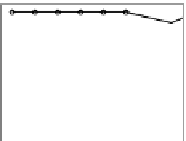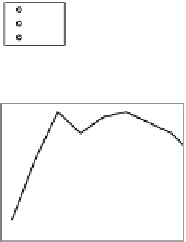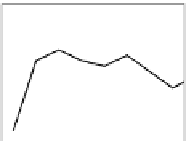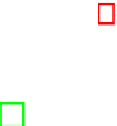Biomedical Engineering Reference
In-Depth Information
Participant 1
Participant 3
Participant 5
1
1
1
0.8
0.8
0.8
0.6
0.6
0.6
Dry
Water
G
el
0.4
0.4
0.4
0.2
0.2
0.2
12
15
18
21
28
32
36
40
12
15
18
21
28
32
36
40
12
15
18
21
28
32
36
40
Participant 2
Participant 4
Participant 6
1
1
1
0.8
0.8
0.8
0.6
0.6
0.6
0.4
0.4
0.4
0.2
0.2
0.2
12
15
18
21
28
32
36
40
12
15
18
21
28
32
36
40
12
15
18
21
28
32
36
40
Frequency [Hz]
Frequency [Hz]
Frequency [Hz]
Fig. 8.
Comparison of optimal classification accuracy across participants
that the comparable accuracy to the gel solution can be achieved with dry and water-
based electrode solutions for users with short thin hair (Participants 1 and 2). However,
for participants with medium and long hair, the performance of water-based electrodes
slightly decreases, and exhibits a significant drop of accuracy for dry electrodes. The
results are in favor of our hypothesis that better design and integration of dry and water-
based electrodes in a headset solution is a prerequisite for good performance in a wide
range of users, having different hair type and length.
Looking into practical aspects of the proposed alternatives to gel electrodes that are
discussed in Section 5, we can infer that users do not perceive dry and water-based
electrodes as less convenient than the gel ones, especially having in mind that they do
not require gel removal after the usage. Given the potential short preparation time, i.e.,
having optimized electrode and headset design such as the one for dry electrodes pre-
sented in [45], and having the possibility to use only dry or only water-based electrodes
without additional loss in signal quality as shown in Figure 6, practical EEG acquisition
systems are achievable. Such systems can provide ITRs of
40
bpm for water-based and
of
20
bpm for dry electrodes, and with the optimized design and application of better
signal processing and classification algorithms, potentially even higher transfer rates
for SSVEP BCI applications.
7
Conclusions
This paper demonstrates that EEG systems that use water-based electrodes and dry con-
tact electrodes can be a viable alternative to traditionally used conductive gel systems
for certain application areas. We have shown that an EEG system that uses dry contact
electrodes and water-based electrodes can be applied to the SSVEP BCI. The mean
information transfer rate in the optimal case, estimated on 6 participants, was
38
bpm
for water-based and
23
bpm for dry electrodes, compared to
67
bpm for gel electrodes.






















































































































































































































































































































Search WWH ::

Custom Search